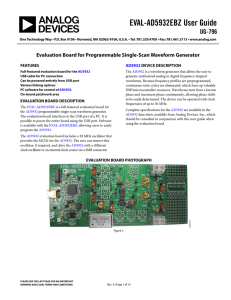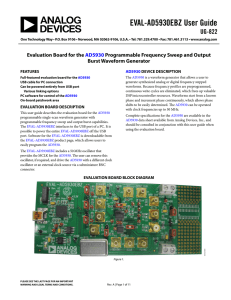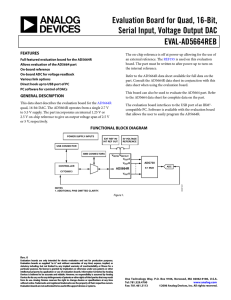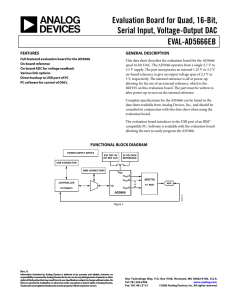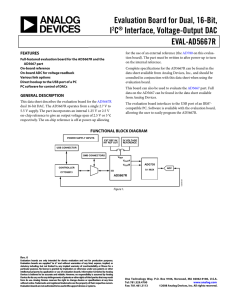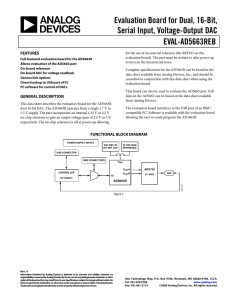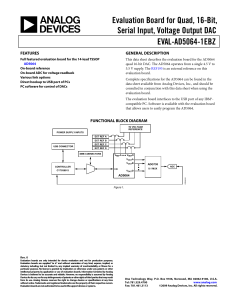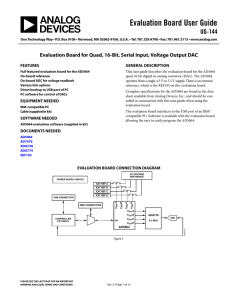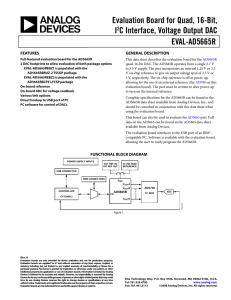Evaluation Board for Programmable Single-Scan Waveform Generator EVAL-AD5932EB
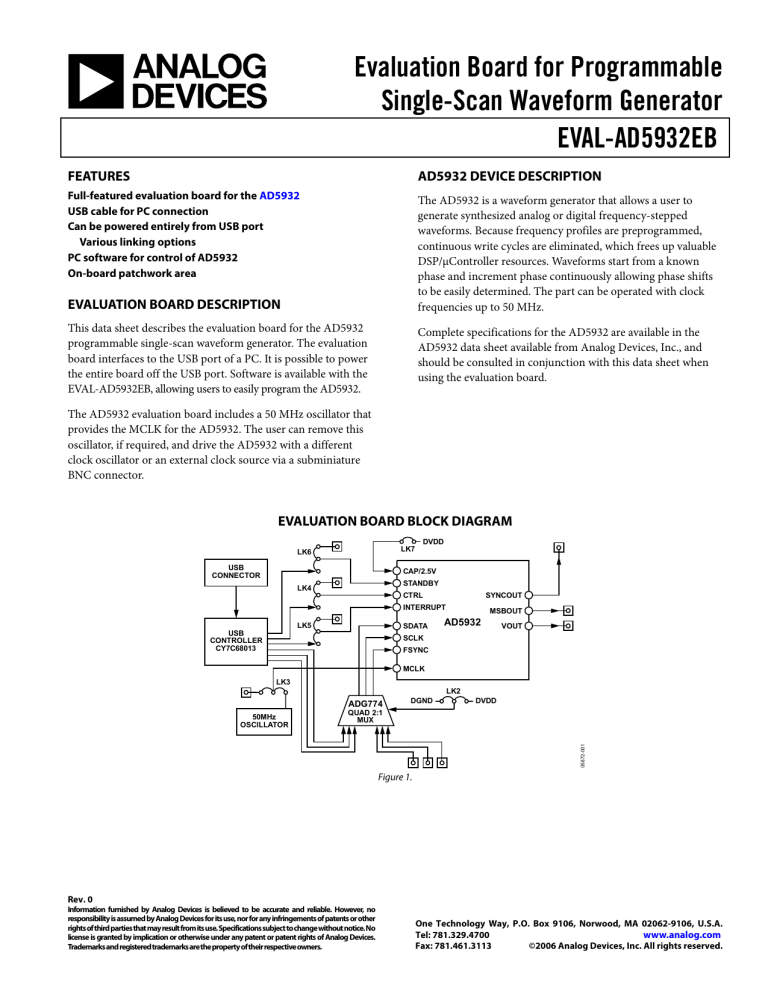
FEATURES
Full-featured evaluation board for the AD5932
USB cable for PC connection
Can be powered entirely from USB port
Various linking options
PC software for control of AD5932
On-board patchwork area
EVALUATION BOARD DESCRIPTION
This data sheet describes the evaluation board for the AD5932 programmable single-scan waveform generator. The evaluation board interfaces to the USB port of a PC. It is possible to power the entire board off the USB port. Software is available with the
EVAL-AD5932EB, allowing users to easily program the AD5932.
Evaluation Board for Programmable
Single-Scan Waveform Generator
EVAL-AD5932EB
AD5932 DEVICE DESCRIPTION
The AD5932 is a waveform generator that allows a user to generate synthesized analog or digital frequency-stepped waveforms. Because frequency profiles are preprogrammed, continuous write cycles are eliminated, which frees up valuable
DSP/μController resources. Waveforms start from a known phase and increment phase continuously allowing phase shifts to be easily determined. The part can be operated with clock frequencies up to 50 MHz.
Complete specifications for the AD5932 are available in the
AD5932 data sheet available from Analog Devices, Inc., and should be consulted in conjunction with this data sheet when using the evaluation board.
The AD5932 evaluation board includes a 50 MHz oscillator that provides the MCLK for the AD5932. The user can remove this oscillator, if required, and drive the AD5932 with a different clock oscillator or an external clock source via a subminiature
BNC connector.
USB
CONNECTOR
USB
CONTROLLER
CY7C68013
EVALUATION BOARD BLOCK DIAGRAM
LK7
DVDD
LK6
LK4
LK5
CAP/2.5V
STANDBY
CTRL
INTERRUPT
AD5932
SDATA
SCLK
FSYNC
SYNCOUT
MSBOUT
VOUT
MCLK
LK3
LK2
DGND DVDD
50MHz
OSCILLATOR
ADG774
QUAD 2:1
MUX
Figure 1.
Rev. 0
Information furnished by Analog Devices is believed to be accurate and reliable. However, no responsibility is assumed by Analog Devices for its use, nor for any infringements of patents or other rights of third parties that may result from its use. Specifications subject to change without notice. No license is granted by implication or otherwise under any patent or patent rights of Analog Devices.
Trademarks and registered trademarks are the property of their respective owners.
One Technology Way, P.O. Box 9106, Norwood, MA 02062-9106, U.S.A.
Tel: 781.329.4700
Fax: 781.461.3113 www.analog.com
©2006 Analog Devices, Inc. All rights reserved.
EVAL-AD5932EB
TABLE OF CONTENTS
Evaluation Board Description......................................................... 1
AD5932 Device Description ........................................................... 1
Evaluation Board Block Diagram................................................... 1
Revision History ............................................................................... 2
Hardware Description...................................................................... 3
Power Supplies .............................................................................. 3
Link Options ................................................................................. 4
REVISION HISTORY
3/06—Revision 0: Initial Version
Evaluation Board Software...............................................................5
Installing the Software ..................................................................5
Using the Software ........................................................................5
Evaluation Board Schematic and Artwork.....................................7
Ordering Information.................................................................... 10
Bill of Materials........................................................................... 10
Ordering Guide .......................................................................... 11
ESD Caution................................................................................ 11
Rev. 0 | Page 2 of 12
HARDWARE DESCRIPTION
POWER SUPPLIES
The AD5932 device has two analog power supply inputs: AVDD
(Analog VDD) and AGND (Analog GND). There are also two digital supplies on the part, DVDD (Digital VDD) and DGND
(Digital GND). Both of these supplies are independent of each other and can be powered from 2.3 V to 5.5 V.
As well as supplying the digital supply for the AD5932, DVDD is used to provide the supply for the 50 MHz oscillator and the
ADG774 quad 2:1 mux.
There are two options available to power the AD5932 evaluation board:
•
The USB port of a computer
•
A power supply
The default option for powering the board is from the USB port
(LK1 and LK8 are in Position B). Alternatively, 2-pin terminal blocks are available to the user for use with an external power supply.
EVAL-AD5932EB
The 5 V from the USB port is regulated to 3.3 V, which provides power for the CY7C68013 USB controller and related USB circuitry. The USB port also provides the GND connections for the board.
When LK1 is in Position B, DVDD is supplied with 3.3 V from the regulator. When LK8 is in Position B, AVDD is powered from DVDD through ferrite bead L1 (600 Ω @ 100 MHz).
When LK1 and LK8 are in Position A, the terminal blocks are used to provide power to the board. Note that if you need to operate the part at a different supply than up to 3.3 V, the terminal blocks should be used. In addition, to abide by the maximum ratings of the AD5932, the board should be used as a standalone board if operating at a voltage less than 3 V.
Therefore, SCLK, SDATA, FSYNC, CTRL, INTERRUPT, and
STANDBY must be externally supplied by the user.
DGND and AGND are connected under the AD5932. Therefore, it is recommended not to connect AGND and DGND elsewhere in the system. AVDD and DVDD are decoupled to the relevant ground plane using a 10 μF tantalum capacitor and a 0.1 μF ceramic capacitor at their source and again at the AD5932.
Rev. 0 | Page 3 of 12
EVAL-AD5932EB
LINK OPTIONS
The link options on the evaluation board should be set for the required operating setup before using the board. The functions of these
links are described in Table 1.
Table 1. Link Options
Link No. Function
LK1 This link selects the power supply source for the digital circuitry (DVDD).
LK2
LK3
LK4
LK5
LK6
LK7
This link controls whether the serial interface of the
AD5932 is being driven from a PC or being used in standalone mode.
This link selects the MCLK source.
This link selects whether the CTRL signal is being driven by software or externally through an SMB.
This link selects whether the INTERRUPT signal is being driven by software or externally through an SMB.
This link selects whether the STANDBY signal is being driven by software or externally through an SMB.
Position Descriptions
Position A selects J2 as the digital circuitry power supply source.
Position B selects the 3.3 V from the ADP3303 regulator that is powered from the USB port as the digital circuitry power supply source.
Position A connects FSYNC, SCLK, and SDATA pins to the
USB controller (controlled from the software).
Position B connects FSYNC, SCLK, and SDATA pins to their respective SMBs (J3, J4, and J5).
Position A selects the on-board oscillator (50 MHz provided).
Position B selects an SMB J13 (labeled MCLK).
Default
Position B
Position A
Position A
Position A connects the CTRL pin to an SMB J6 (labeled CTRL).
Position B connects the CTRL pin to the USB controller for software control.
Position A connects the INTERRUPT pin to an SMB J7
(labeled INTERRUPT).
Position B connects the INTERRUPT pin to the USB controller for software control.
Position B
Position B
Position A connects the STANDBY pin to the STANDBY SMB
J8 (labeled STANDBY).
Position B connects the STANDBY pin to the USB controller for software control.
Position B
Removed
LK8
Insert this link to connect the CAP/2.5 V pin to
DVDD if operating DVDD at < 2.5 V.
This link selects the power supply source for the analog circuitry (AVDD).
Position A selects J14 as the analog circuitry supply source.
Position B connects AVDD to DVDD through a ferrite bead L1
(600 Ω @ 100 MHz) and a 1.6 Ω resistor (R16).
Position B
Rev. 0 | Page 4 of 12
EVALUATION BOARD SOFTWARE
The AD5932EB evaluation kit is shipped with a CD-ROM that includes self-installing software. The PC is connected to the evaluation board using the supplied cable. The evaluation software should be installed before connecting the evaluation board to the PC’s USB port. This ensures that the evaluation board is correctly recognized when connected to the PC.
The software is compatible with Windows® 2000 and Windows XP.
INSTALLING THE SOFTWARE
To install the software:
1.
Start the Windows operating system and insert the CD.
The installation software should launch automatically. If it does not, use Windows Explorer to locate the file setup.exe on the CD. Double-click this file to start the installation procedure.
2.
At the prompt, select a destination directory. By default, this is C:\Program Files\Analog Devices\AD5932 .
Once the directory is selected, the installation procedure copies the files into the relevant directories on the hard drive. The installation program creates a program group called Analog Devices with subgroup AD5932 in the Start menu of the taskbar.
3.
Once the installation procedure is complete, power up the
AD5932 evaluation board as described in the Hardware
Description section and connect it to the USB port of the
PC using the cable supplied.
4.
Double-click the AD5932 icon to start the program. The evaluation board is then automatically detected.
USING THE SOFTWARE
To launch the software, click on Start > All Programs > Analog
Devices > AD5932 > AD5932 Evaluation Software.
The software for the AD5932 board is presented in wizard format.
Note that no download of data to the evaluation board takes place until you click the Write to Part command button in the
last screen (see Figure 6). This means that it is possible to use
the software to help calculate the required write sequence without having the board attached to the computer.
EVAL-AD5932EB
Figure 2. First Window in Wizard
Figure 2 displays the first window in the wizard. The first series
of questions relate to the required write to the control register.
Follow the wizard prompts by selecting the desired answers and click Next to proceed to the next screen. The text box labeled
Control register write is a read-only text box and cannot be changed. It is intended to show the effect your selections have on the control register write.
Both internal and external options for frequency incrementing are offered. More details on all of these options can be found in the AD5932 data sheet.
Figure 3. Internal/External Increment Options
After completing the control register write section, you are required to enter the frequency of MCLK. This value is then used to calculate all frequency and time values throughout the software.
Rev. 0 | Page 5 of 12
EVAL-AD5932EB
The next steps in the wizard require you to enter the values for the numeric registers: the start frequency (F
START
), frequency increments (
Δ f), number of increments (N
INCR
), time interval
(T
INT
), and burst interval (T
BURST
). Figure 4 shows the first screen
of this wizard where F
START
,
Δ f, and N
INCR
are entered. This can be done by entering the hexadecimal value directly or by entering the values in MHz (the software then calculates the corresponding hexadecimal value). Click Next to enter T
INT
and T
BURST
.
The final screen (Figure 6) displays the required write sequence
in hexadecimal, which is calculated based on the responses of the earlier questions. Now click Write to Part , which is the first communication with the board. This write programs the AD5932 registers. However, it is necessary to click Pulse CTRL Pin in order to start the frequency sweep.
Figure 4. Numeric Registers Values
The SYNC and MSB outputs are also available from the
AD5932 evaluation board. The MSB output can be enabled in the first window of the wizard, while both options for the
SYNCOP are available, as shown in Figure 5.
Figure 6. Final Screen
Figure 5. SYNCOP Pin Options
Rev. 0 | Page 6 of 12
EVALUATION BOARD SCHEMATIC AND ARTWORK
EVAL-AD5932EB
Figure 7. EVAL-AD5932EB Schematic, Page 1 of 2
Rev. 0 | Page 7 of 12
EVAL-AD5932EB
Figure 8. EVAL-AD5932EB Schematic, Page 2 of 2
Rev. 0 | Page 8 of 12
EVAL-AD5932EB
Figure 9. EVAL-AD5932EB Silkscreen Artwork
Figure 10. EVAL-AD5932EB Component Side Artwork
Figure 11. EVAL-AD5932EB Solder Side Artwork
Rev. 0 | Page 9 of 12
EVAL-AD5932EB
ORDERING INFORMATION
3
4
5
BILL OF MATERIALS
Table 2.
Item Qty Reference
1 3 C1, C2, C6
2 1 C10
2
1
1
C18, C26
C24
C23
12
13
14
15
16
17
18
7
8
9
10
11
3
1
1
1
7
1
2
6
1
1
2
10
19
20
1
1
R17
R3
21 2 R4, R5
22 1 R9
23 26 T1 to T26
24 1 U1
25 1 U2
26 1 U3
27
28
29
30
1
1
1
1
U4
U5
U7
Y1
C17, C20, C27, C28, C30, C31, C32,
C33, C34, C35, C36, C37
C9, C11, C13, C16, C19, C29
D2
J1
J2, J14
J3, J4, J5, J6, J7, J8, J9, J10, J11, J13
L1
LK1, LK2, LK3, LK4, LK5, LK6, LK8
LK7
R1, R2
R10, R11, R12
R15
R16
Description
22 pF 0603 Ceramic Capacitor
2.2 uF 0805 Ceramic Capacitor
0603 Capacitor
0805 Capacitor
0.01 μF 0603 Ceramic Capacitor
0.1 μF 0603 Ceramic Capacitor
10 μF TAJA Tantalum Capacitor
Green LED
USB Mini-B Connector (usb-otg)
2-Pin Terminal Block (5mm Pitch)
Subminiature BNC Connector (SMB)
Ferrite Bead (600 Ω @ 100MHz)
3-Pin SIL Header (with shorting block)
2-Pin SIL Header (with shorting block)
2.2 kΩ 0603 Resistor
10 kΩ 0603 Resistor
0603 Resistor
1.5 Ω 0603 Resistor
0 Ω Short
1 kΩ 0603 Resistor
100 kΩ 0603 Resistor
50 Ω 0603 Resistor
Testpoint
AD5932
IC Serial EEPROM 64 K 2.5 V 8-SOIC
CY7C68013-CSP USB Microcontroller
Quad SPDT Switch/2:1 mux
50 MHZ CMOS/TTL Crystal (and 14-Pin DIP)
24 MHz CM309S SMD Crystal
Rev. 0 | Page 10 of 12
Supplier/No.
FEC 722-005
Digikey 445-1588-1-ND
Not Inserted
Not Inserted
FEC 722-066
FEC 499-675
FEC 331-3888
FEC 515-620
FEC 476-8309
FEC 151-785
FEC 310-682
FEC 581-094
FEC 512-047 and 150-411
FEC 511-705 and 150-411
FEC 911-276
FEC 911-355
Not Inserted
FEC 758-267
FEC 772-227
FEC 911-239
FEC 911-471
FEC 422-1825
FEC 240-333
AD5932
Digikey 24LC64-I/SN-ND
ADP3303AR-3.3
Embassy CY7C68013-56LFC
ADG774BRQ
FEC 788-480/97103
FEC 569-872
ORDERING GUIDE
Model Description
EVAL-AD5932EB Evaluation Board
ESD CAUTION
ESD (electrostatic discharge) sensitive device. Electrostatic charges as high as 4000 V readily accumulate on the human body and test equipment and can discharge without detection. Although this product features proprietary ESD protection circuitry, permanent damage may occur on devices subjected to high energy electrostatic discharges. Therefore, proper ESD precautions are recommended to avoid performance degradation or loss of functionality.
EVAL-AD5932EB
Rev. 0 | Page 11 of 12
EVAL-AD5932EB
NOTES
©2006 Analog Devices, Inc. All rights reserved. Trademarks and
registered trademarks are the property of their respective owners.
EB05872-0-3/06(0)
Rev. 0 | Page 12 of 12
